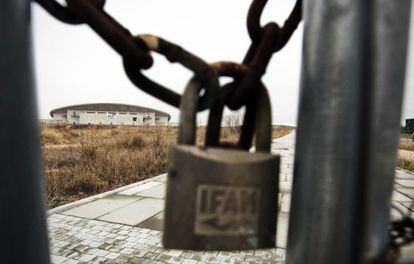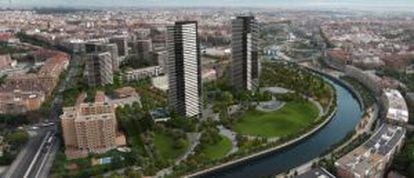New Atlético Madrid soccer stadium delayed again
Club will not move to La Peineta before 2017 after constructor decides to renegotiate deal

Atlético Madrid soccer team’s move to its new home in the east of the capital will not go ahead until at least the summer of 2017, after construction company FCC decided to renegotiate its deal with the club.
The new date represents a delay of another year for a project already plagued by postponements. La Peineta stadium was originally scheduled to open in 2015.
FCC has decided to freeze building work while it works out a “re-planning” of its agreement with the club.
The contract, which was signed in 2010, planned to finance the new arena via the sale of thousands of homes built on the land where the club’s current stadium, the Vicente Calderón, now stands.
The story goes back to 2008, when Madrid City Hall signed a deal with Atlético to transfer the club to the old La Peineta municipal stadium, which had a seating capacity of 73,000, 20,000 more than the Calderón.
La Peineta had been inaugurated in 1994 at a cost of €50 million, but was “underutilized” and “in a serious state of disrepair,” according to city authorities who had planned to convert it into an Olympic stadium as part of their bid for the Games.
The club agreed to buy the plot of land on which the stadium stood, in the San Blas district, for €41.2 million. The stadium itself was valued at zero euros, but under the terms of the agreement, Atlético had to build a new one in its place before June 2015, at a cost of €195 million.
To fund the project, in June 2010 Atlético signed a deal with FCC and Mahou, the brewer that had an old plant near the Calderón, under which the construction firm would demolish both the stadium and the beer factory, build 2,000 new homes, and bring the last remaining ground-level section of the M-30 beltway underground, thus completing the city’s new riverside park, Madrid Río.
The profits from the property sales would be sufficient to cover all these costs, the contract figured.
But in the post-property-boom era, the numbers no longer add up. Sources at FCC said the collapse of the market was forcing them to renegotiate the economic terms of the agreement. Construction of the new and improved La Peineta has been halted “momentarily,” and will now not be completed until at least the summer of 2017.

The same sources also said that, beside the financial difficulties, there were added legal insecurities holding the project back.
In 2009 the Popular Party (PP)-controlled city government approved changes to zoning laws to allow 17-story towers to go up in an area where the maximum building height was four floors. An association of Atlético members challenged the plans in the courts, and the Madrid regional High Court ruled in their favor in January 2012.
The city appealed to the Supreme Court, and the Madrid regional government, also ruled by the PP, changed its land laws to bypass the legal impediment. In October of last year, the Supreme Court struck down the earlier ruling on the grounds that Mahou’s position had not been taken into account, and ordered the entire case restarted from the beginning.
But in the meantime, the regional land laws have enabled the city to approve a new zoning plan that envisions two skyscrapers, eight apartment buildings and a large park on the site now occupied by the Vicente Calderón. If new problems do not arise – the association is considering new legal action – this project should be completed by 2022 or 2023.










































